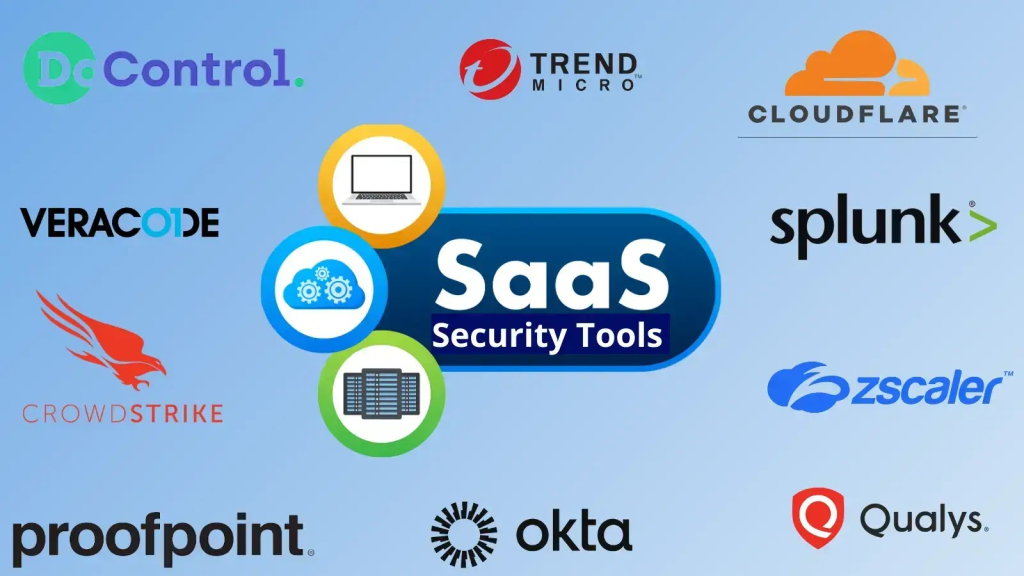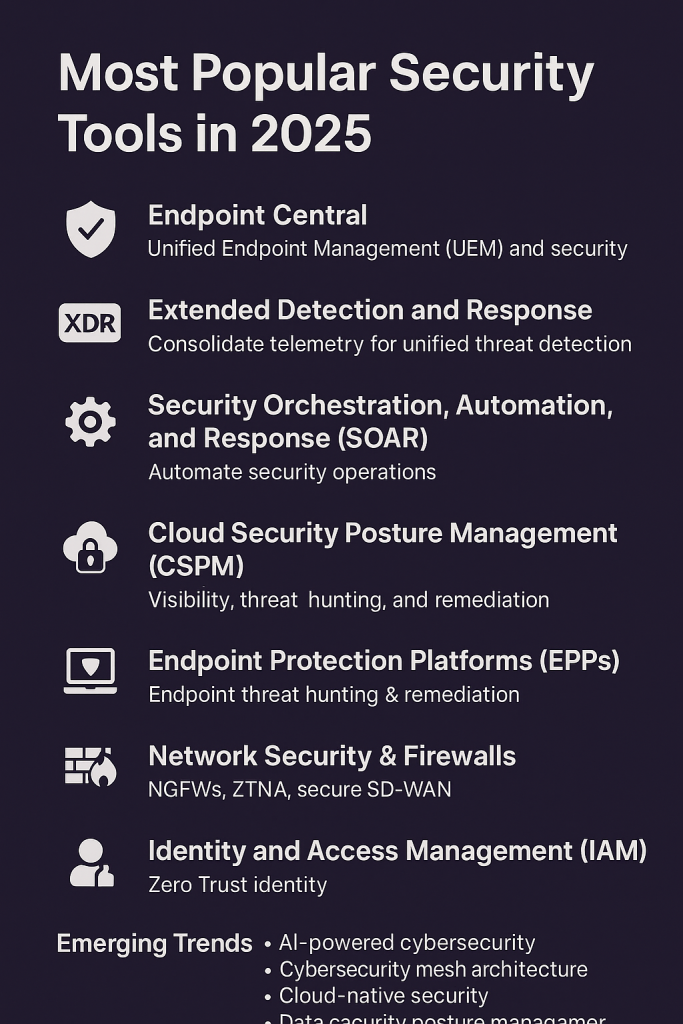
The cybersecurity landscape continues to evolve rapidly in 2025, driven by increasingly sophisticated threats, hybrid cloud infrastructures, remote workforces, and emerging technologies like AI and Zero Trust Architecture. Organizations must now adopt a multi-layered, proactive security approach powered by modern tools that go far beyond traditional antivirus solutions.
Here’s a detailed look at the most popular security tools dominating 2025, across various critical domains:

 1. Unified Endpoint Management (UEM) and Security — Endpoint Central
1. Unified Endpoint Management (UEM) and Security — Endpoint Central

Modern organizations demand centralized management and security enforcement across diverse devices — desktops, laptops, mobile devices, servers — all from a single pane of glass.

ManageEngine Endpoint Central (formerly Desktop Central)

- Unified Endpoint Management (UEM) for Windows, macOS, Linux, Android, and iOS.
- Automated patch management and software deployment.
- Advanced endpoint security modules (vulnerability scanning, BitLocker management, ransomware protection).
- Remote troubleshooting tools and analytics.
- Affordable compared to Microsoft Intune and VMware Workspace ONE.

- Patch automation
- Remote device control
- Mobile Device Management (MDM)
- Endpoint detection and response (EDR) capabilities (with Security Edition)
 2. Extended Detection and Response (XDR)
2. Extended Detection and Response (XDR)

XDR consolidates telemetry from endpoints, networks, cloud, and identity sources to deliver unified threat detection, investigation, and response.

- CrowdStrike Falcon XDR — market leader for lightweight, cloud-native protection.
- Palo Alto Networks Cortex XDR — strong integration with firewalls and cloud.
- Microsoft Defender XDR — integrated across Azure, Windows, and Microsoft 365.
- SentinelOne Singularity XDR — AI-driven autonomous detection and response.
 3. Security Orchestration, Automation, and Response (SOAR)
3. Security Orchestration, Automation, and Response (SOAR)

Automating repetitive security operations to accelerate incident response and free up analysts.

- Palo Alto Cortex XSOAR — widely used orchestration platform with playbooks.
- Splunk SOAR (Phantom) — robust integration with security information and event management (SIEM).
- IBM Security QRadar SOAR — strong incident workflow capabilities.
- Rapid7 InsightConnect — easy-to-use, plug-and-play automation.
 4. Cloud Security Posture Management (CSPM)
4. Cloud Security Posture Management (CSPM)

Visibility, compliance, and threat detection across multi-cloud and hybrid cloud environments.

- Wiz — rising star, agentless cloud security scanning.
- Prisma Cloud (Palo Alto Networks) — full-stack cloud-native security.
- Microsoft Defender for Cloud — integrated security posture management for Azure, AWS, GCP.
- Lacework — cloud workload protection and behavioral analytics.
 5. Endpoint Protection Platforms (EPPs) and EDR
5. Endpoint Protection Platforms (EPPs) and EDR

EPPs have evolved into advanced Endpoint Detection and Response (EDR) systems, offering behavior-based threat hunting and automated remediation.

- CrowdStrike Falcon Endpoint Protection — real-time protection with minimal system impact.
- SentinelOne Singularity EPP+EDR — AI-powered autonomous detection.
- Sophos Intercept X — deep learning threat detection and anti-ransomware.
- Microsoft Defender for Endpoint — strong native Windows integration.
 6. Network Security & Firewalls
6. Network Security & Firewalls

Shift to Next-Generation Firewalls (NGFWs), Zero Trust Network Access (ZTNA), and secure SD-WAN.

- Palo Alto Networks NGFW — industry leader with App-ID and threat prevention.
- Fortinet FortiGate — strong SD-WAN and UTM capabilities.
- Cisco Secure Firewall — formerly Cisco Firepower, focusing on hybrid deployments.
- Check Point Quantum Security Gateway — solid threat prevention with AI integration.
 7. Identity and Access Management (IAM)
7. Identity and Access Management (IAM)

Zero Trust Identity — continuous verification, minimal access, and adaptive authentication.

- Okta Workforce Identity Cloud — #1 independent IAM platform.
- Microsoft Entra ID (formerly Azure Active Directory) — Microsoft’s new, expanded identity service.
- Ping Identity — strong enterprise Single Sign-On (SSO) and multi-factor authentication (MFA).
- Duo Security (Cisco) — simple, effective MFA and Zero Trust security.
 Emerging Trends in Security (2025 and Beyond)
Emerging Trends in Security (2025 and Beyond)
- AI-Powered Cybersecurity:
Machine Learning and AI automate threat detection, predictive analytics, and incident response (e.g., CrowdStrike Charlotte AI, SentinelOne Purple AI). - Cybersecurity Mesh Architecture (CSMA):
Distributed identity-first security models instead of perimeter-centric models. - Cloud-Native Security:
Shift-left security, secure by design, embedded in DevOps pipelines (e.g., Prisma Cloud, Wiz). - Data Security Posture Management (DSPM):
Focused on securing sensitive data across cloud and on-premises environments.
 How to Choose the Right Security Tools?
How to Choose the Right Security Tools?
| Criteria | Tips |
|---|---|
| Security Needs | Understand your risk areas (endpoint, cloud, identity, etc.) |
| Integration | Choose tools that integrate well with your SIEM/SOAR ecosystems |
| Automation | Prioritize tools with smart automation and low human overhead |
| Scalability | Pick solutions that grow with your organization |
| Ease of Use | Balance power with usability — avoid tools that require heavy tuning |
| Cost vs Value | Cheaper isn’t always better — focus on effectiveness and TCO (total cost of ownership) |
 Final Words
Final Words
“Security is no longer an IT concern; it’s a core business function.”
The tools listed above represent the gold standard in cybersecurity for 2025.
As threats become faster and smarter, investing in the right mix of proactive, intelligent, and unified security tools is not optional — it’s critical.
Stay vigilant. Stay secure.
 Quick Recap:
Quick Recap:
- Endpoint Central — Best for unified endpoint management and security.
- CrowdStrike, Palo Alto, Microsoft Defender — Lead XDR and endpoint protection.
- Prisma Cloud, Wiz — Top cloud-native security.
- Okta, Microsoft Entra ID — Identity security champions.
Say goodbye to the hassles of bike ownership! MotoShare.in offers affordable rentals, whether you need a scooter for errands, a bike for a road trip, or a reliable ride to explore new cities.

 Starting: 1st of Every Month
Starting: 1st of Every Month  +91 8409492687
+91 8409492687  Contact@DevOpsSchool.com
Contact@DevOpsSchool.com
